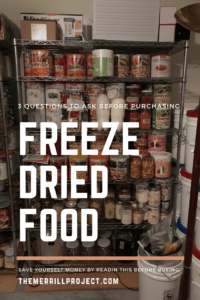
Freeze-dried food has been the new food storage craze over the past 8 or so years. And I don’t blame them! The food lasts better in long term food storage because there is less moisture in it (which tends to ruin food storage). Freeze-dried food is lightweight. It re-hydrates much quicker than dehydrated and keeps a similar form when rehydrated as well. Really, the only downside to freeze-dried food is the price. If you are fortunate enough to be able to purchase a freeze dryer which is well over $1000, then purchasing freeze-dried food from any store comes with a hefty price tag.
That being said there are 3 things you want to ask yourself BEFORE buying freeze dried food.
*Updated November 2020* – This post contains affiliate links. Read my affiliate link disclosure here
3 Questions to Ask Before Buying Freeze Dried Food
Here are some tips to check out to save you the most money for your freeze-dried foods. (Hint: almost all the companies get their main food from the same suppliers).
Download your FREE Food Storage Plan with recipes and shopping lists today!
1. What is the serving size?
Before buying freeze-dried food, it’s important to look at the serving size. Each company has different serving sizes. One company might have 1/3 cup servings while the other company has 1/4 cup servings. This can make a HUGE difference when looking at how much is in the can.
For example:
50 servings of 1/3 cup = 16.6 cups total. VS 50 servings of 1/4 cups = 12.5 cups. That’s 4 cups difference!
2. What is the weight?
Another area freeze dried companies try to trick you is with the weight. It is especially important with bulk food storage buckets (with more than one meal included). Many buckets will tell you it has 100 servings in there, and not tell you the size of servings (or there is a variety of serving sizes and they only tell you the biggest). In this case, you want to look at the overall ITEM weight of the product compared to the price. Comparing dollar per ounce is the best.
For example:

This Mountain House bucket (on sale for $75.71) advertises 29 servings and is 55.2 oz. This makes it $1.31 per ounce.

This Wise Food Storage bucket (on sale for $119.55) advertises 156 servings and is 42 oz. This makes the price $2.84 per ounce.
That’s DOUBLE the price, but it looks like a better deal because it has 5 times more servings!
Download your FREE Food Storage Plan with recipes and shopping lists today!
3. What is the shipping cost?
Before buying freeze-dried food, you will want to look at the shipping costs. A few years ago Thrive used to charge shipping weight per the cost of how much you ordered. Shipping prices could be up to $50 for just one order. Since then, they have lowered prices and even offer free shipping at times (when you purchase a certain amount).
Honeyville used to offer $4.99 shipping not matter the order size, but has since changed it the end of 2018 to $8.99 for any order size. (If I had a crying emjoi it would be entered here). They still have better shipping prices than some other companies, but they are now on a more equal playing field… on the shipping side of things.
Shipping cost is something to be aware of, as it can make or break the deal with purchasing from a company. And beware of companies that charge more shipping for more product. A flat rate shipping is typically your best price.
Download your FREE Food Storage Plan with recipes and shopping lists today!
In Conclusion
It’s important you do your research and ask yourself these 3 questions before buying freeze dried food to save yourself money and frustration.
What’s your favorite freeze dried food company and why? Comment below!
Further Reading:
Long Term Food Storage Options
What Type of Food Storage Is Best?
If you liked this post, please let us know by leaving a comment below and clicking those share buttons to tell your friends. As always, we appreciate you taking a minute of your time to spread the word about preparedness.

2 thoughts on “Before Buying Freeze Dried Food- 3 Questions To Ask Yourself”
When I look at a freeze dried pouch, can, or bucket I look at calories since the other measurements (weight and number of servings) can vary from one brand to another. And then I base a realistic number of servings on a 2000 calorie per day requirement. Of course I also see how much of that is just added sugar and will avoid items (other than drink mixes) that are high in sugar since that’s not healthy as a long term supply.
I have a mix of pre-made FD meals and FD ingredients for making our own meals post-event. The pre-made meals are important in case people are sick and unable to cook a full meal, but the individual ingredients are healthier since we can choose how much salt, fat, carbs, etc goes into the meal.
Those are some really good tips and things to take note of! We have a few pre-made freeze dried meals, but definitely prefer making our own meals with those ingredients.